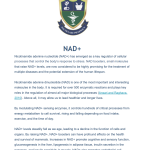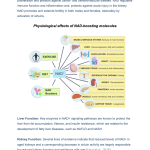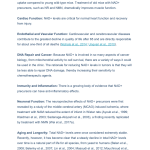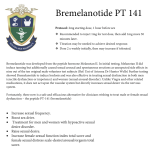Peptide Therapies
There are many different types of Peptides that help improve your overall health and wellness. They are designed to supplement the decreasing levels of essential amino acids and peptides in the body. Certain amino acids are responsible for the production of hormones and proteins that help our body to function at its best.If you’re looking for a way to safely and effectively improve or regulate specific bodily functions, then Peptides may be for you. Various peptide treatments have been shown to improve everythingfrom muscle tone and metabolism to sexual arousal and immune functions. Peptide treatments are extremely versatile and have proven to be very effective.

Our Preferred Peptides
NAD+
Nicotinamide adenine nucleotide (NAD+) has emerged as a key regulator of cellular processes that control the body’s response to stress. NAD boosters, small molecules that raise NAD+ levels, are now considered to be highly promising for the treatment of multiple diseases and the potential extension of the human lifespan. Nicotinamide adenine dinucleotide (NAD) is one of the most important and interesting molecules in the body. It is required for over 500 enzymatic reactions and plays key roles in the regulation of almost all major biological processes (Ansari and Raghava, 2010). Above all, it may allow us to lead healthier and longer lives. By modulating NAD+ sensing enzymes, it controls hundreds of critical processes from energy metabolism to cell survival, rising and falling depending on food intake, exercise, and the time of day.
PT-141
PT-141 was originally created to resolve female sexual dysfunction. By stimulating the melanocortin receptors in the brain, it works to stimulate sexual arousal for both men and women. It has also been known to have other positive benefits, like boosted energy and a natural tan.
Let’s take a closer look at how PT-141 can lead to a happier, healthier you.
Side effects of PT-141 are mostly linked to high dosages. These include an increase in cortisol levels, fleeting bouts of headache, nausea, and flushing. However, headaches experienced from other popular ED medications were more intense and lasted far longer than those who experienced them with PT 141.
TB-500
- Increased cells in healing.
- Improves cell migration to the site of the injury.
- Soft tissue repair - tendon, ligament, muscle sports, and athletic injuries.
- Reduces scar tissue.
- Improves the mortality rate.
- Significant repair and regenerative properties.
- Enlarged muscle growth, muscle tone, and muscular stamina.
TB-500 is a synthetic fraction of the 43 amino
acid protein thymosin beta-4. The main
purpose of this peptide is to promote
healing. The healing effects of TB-500 have
been observed in tendons, ligaments,
muscles, skin, heart, and eyes.
BPC-157 (Pentadeca Arginate)
BPC 157, composed of 15 amino acids, is a partial sequence of body protection compound (BPC) that is
discovered in and isolated from the human gastric juice. Experimentally it has been demonstrated to accelerate
the healing of many different wounds, including tendon-to-bone healing and superior healing of damaged
ligaments. Also, BPC 157 seems to protect organs and to prevent ulcers of the stomach. This peptide is also
shown to decrease pain in damaged areas. Those who suffer from discomfort due to muscle sprains, tears and
damage may benefit from treatment with this peptide. It can also help aid skin burns to heal at a faster rate and
increase blood flow to damaged tissues.
• Tendon healing.
• Decrease pain.
• Increase collagen synthesis.
• Quicker recovery times post-injury.
• Wound and bone healing.
• Decrease inflammation.
• Intestinal issues.
• Protects the heart.
GHK-Cu Copper Peptide
GHK-Cu is a naturally occurring copper complex that was first identified in human plasma. Copper peptides are small, naturally occurring protein fragments that have a high affinity for copper ions, which are critical to normal body function. The human peptide GHK (glycyl-l-histidyl-l-lysine) has multiple biological actions, all of which, according to our current knowledge, appear to be health positive. It stimulates blood vessel and nerve outgrowth, increases collagen, elastin, and glycosaminoglycan synthesis, as well as supports the function of dermal fibroblasts. GHK’s ability to improve tissue repair has been demonstrated for skin, lung connective tissue, boney tissue, liver, and stomach lining. Since its discovery in 1973, GHK-Cu established itself as a powerful protective and regenerative ingredient, which is currently widely used in skin and hair products. First, it seems to act as a potent protector of tissue and anti-inflammatory agent that controls the oxidative damage that occurs post-tissue injury. It then plays a significant role in signaling tissue remodeling which removes damaged/scarred tissue and generates new, healthy tissue. However, these positive effects decline with age because the concentration of GHK-Cu in the body decreases with age. Thus, there is an increase in inflammation, cancerous activity, and tissue destruction.
• Tighten loose skin and reverse thinning of aged skin.
• Repair protective skin barrier proteins.
• Improve skin firmness, elasticity, and clarity.
• Reduce fine lines, depth of wrinkles, and improve the structure of aged skin.
• Smooth rough skin.
• Reduce photodamage, mottled hyperpigmentation, skin spots, and lesions.
• Improve overall skin appearance.
• Stimulate wound healing.
• Protect skin cells from UV radiation.
• Reduce inflammation and free radical damage.
• Increase hair growth and thickness, enlarge hair follicle size.
Sermorelin GRF 1-29
- Improvements in wellbeing and libido.
- Augmented restful sleep leads to better cognitive functions.
- Refined skin tone with stronger hair and nails.
- Decrease in mean systolic blood pressure.
- Improvement in fat loss and lean mass gains.
- Increased endurance and strength.
- Significant increases in GH release two hours after administration.
- Elevated mean 24-h GH, peak GH amplitude, and GH area under the peaks.
GH secretagogues can promote pituitary health and function during aging. Sermorelin, an analog of naturally occurring growth hormone-releasing hormone (GHRH) whose activity declines during aging, may presently offer a more immediate and better alternative to rhGH for GHRT in aging. Pituitary recrudescence resulting from sermorelin helps slow the cascade of hypophyseal hormone failure during aging, thereby preserving not only youthful anatomy but also youthful physiology. Sermorelin [GRF(1-29)] is a GHRH analog derived from the first 29 amino acids of the GHRH protein. Sermorelin impacts the hypothalamic-pituitary-somatotropic axis through the GHRH receptor. Sermorelin stimulates pituitary gene transcription of hGH messenger RNA, increasing pituitary reserve and preserving more of the growth hormone neuroendocrine axis, which is the first to fail during aging. It has a half-life of about 10-20 minutes. Sermorelin is found to augment the duration of rhythmic GH release without pushing serum levels above physiologic norms. In studies, Sermorelin therapy almost doubled the 12-h mean amount of GH released. Analysis of the nocturnal GH production showed that this increase in GH release was limited to approximately two hours after sermorelin administration. Studies indicate Sermorelin can stimulate GH and IGF-1 secretion, but this depends on the frequency of dosing and the timing of serum hormone measurement. Sermorelin stimulates the patient's pituitary gland by binding to specific receptors to increase the production and secretion of endogenous HGH.





